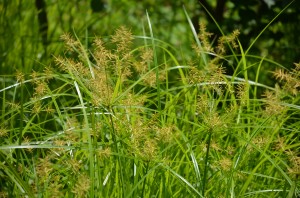Yellow nutsedge, aka “nutgrass” (Cyperus esculentus) is a nasty weed found in lawn and garden areas. It is a sedge, and not a grass, and methods of eliminating it vary. Yellow nutsedge is easily identified by its yellow to light green glossy leaves and the triangular shape of the stem. It grows most actively during the warm spring and summer months.
Yellow nutsedge is a perennial which reproduces primarily by small underground tubers or nutlets. It also spreads by rhizomes (underground stems). The nutlets often spread from contaminated soil which you have transported into your garden.
Maintaining a healthy dense growing lawn or garden bed is best way to avoid yellow nutsedge infestations. For small infestations, judicious hand pulling will eliminate it. This may take several weeks as the underground nutlets may re-sprout.
Mid-spring thru early summer is the ideal time to control yellow nutsedge in the Southern Appalachian region (USDA hardiness zones 6 and 7). The plant is young, actively growing, and the nutlets have not matured. By late summer the seedheads have formed and is very difficult to control at this time.
For treating large infested areas, use of chemical weed killers (herbicides) may be your best option. Available to homeowners are herbicide products containing the ingredient MSMA (methanearsonate). MSMA is packaged under several product brand names. The herbicide works better if the lawn or garden area is irrigated a day or two prior to application. Continue to repeat herbicide applications until all nutsedge plants are eliminated.
For selective control of nutsedge in lawn areas, without injuring the lawn grass, Basagran™ (bentazon) and Manage® (halosulfuron) are available. However, these two products are not available to homeowners and are applied solely by certified landscape professionals only.


 Posted in
Posted in 
